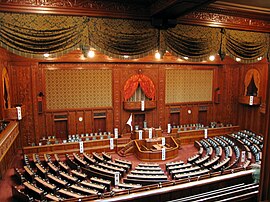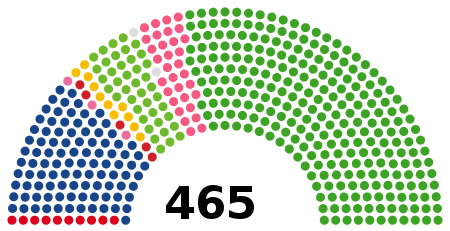
A | B | C | D | E | F | G | H | CH | I | J | K | L | M | N | O | P | Q | R | S | T | U | V | W | X | Y | Z | 0 | 1 | 2 | 3 | 4 | 5 | 6 | 7 | 8 | 9
35°40′30.6″N 139°44′41.8″E / 35.675167°N 139.744944°E
House of Representatives 衆議院 Shūgiin | |
|---|---|
| 213th Session of the National Diet | |
 | |
| Type | |
| Type | of the National Diet |
| Leadership | |
Leader of the Opposition | |
| Structure | |
| Seats | 465 |
 | |
Political groups | Government (289)
Opposition (168) Unaffiliated (7)
Vacant (1)
|
| Committees | 17 committees |
Length of term | Up to 4 years |
| Salary | Speaker: ¥2,170,000/m Vice Speaker: ¥1,584,000/m Members: ¥1,294,000/m |
| Elections | |
| Parallel voting: First-past-the-post voting (289 seats) Party-list proportional representation (176 seats) | |
First election | 1 July 1890 |
Last election | 31 October 2021 |
Next election | On or before 30 October 2025 |
| Meeting place | |
 | |
| Chamber of the House of Representatives | |
| Website | |
| www | |
| This article is part of a series on |
| Politics of Japan |
|---|
 |
|
|
The House of Representatives (衆議院, Shūgiin) is the lower house of the National Diet of Japan. The House of Councillors is the upper house. The composition of the House is established by Article 41 and Article 42 of the Constitution of Japan.[1] The House of Representatives has 465 members, elected for a four-year term. Of these, 176 members are elected from 11 multi-member constituencies by a party-list system of proportional representation, and 289 are elected from single-member constituencies.
The overall voting system used to elect the House of Representatives is a parallel system, a form of semi-proportional representation. Under a parallel system, the allocation of list seats does not take into account the outcome in the single seat constituencies. Therefore, the overall allocation of seats in the House of Representatives is not proportional, to the advantage of larger parties. In contrast, in bodies such as the German Bundestag or the New Zealand Parliament the election of single-seat members and party list members is linked, so that the overall result respects proportional representation fully or to some degree.[citation needed]
The House of Representatives is the more powerful of the two houses, able to override vetoes on bills imposed by the House of Councillors with a two-thirds majority.[2][3][4]
The last election for the House of Representatives was held on 31 October 2021 in which the Liberal Democratic Party won a majority government with 261 seats. Along with their coalition partner, Komeito which won 32 seats, the governing coalition holds 293 seats in total.[5]
Right to vote and candidature
- Japanese nationals aged 18 years and older may vote (prior to 2016, the voting age was 20).[6]
- Japanese nationals aged 25 years and older may run for office in the lower house.
Differences between the Upper and Lower Houses
The House of Representatives has several powers not given to the House of Councillors. If a bill is passed by the lower house (the House of Representatives) but is voted down by the upper house (the House of Councillors) the House of Representatives can override the decision of the House of Councillors by a two-thirds vote in the affirmative. However, in the case of treaties, the budget, and the selection of the prime minister, the House of Councillors can only delay passage, but not block the legislation. As a result, the House of Representatives is considered the more powerful house.
Members of the House of Representatives, who are elected to a maximum of four years, sit for a shorter term than members of the House of Councillors, who are elected to full six-year terms. The lower house can also be dissolved by the Prime Minister or the passage of a nonconfidence motion, while the House of Councillors cannot be dissolved. Thus the House of Representatives is considered to be more sensitive to public opinion, and is termed the "lower house".
While the legislative term is nominally 4 years, early elections for the lower house are very common, and the median lifespan of postwar legislatures has in practice been around 3 years.
Current composition

| ||||
| In-House Groups kaiha |
Parties | Seats by parties |
Seats | |
|---|---|---|---|---|
| Government | 290 | |||
| Liberal Democratic Party Jiyūminshutō / Mushozoku no Kai Liberal Democratic Party / Association of independents |
Liberal Democratic Party (LDP) | 257 | 258 | |
| Independent | 1 | |||
| Komeito Kōmeitō |
Komeito | 32 | 32 | |
| Opposition | 164 | |||
| The Constitutional Democratic Party of Japan Rikken Minshutō・Mushozoku Constitutional Democratic Party / Independents |
Constitutional Democratic Party (CDP) | 98 | 100 | |
| Social Democratic Party (SDP) | 1 | |||
| Independent | 1 | |||
| Nippon Ishin (Japan Innovation Party) and Free Education for All Nippon Ishin no Kai / Kyōiku mushō-ka o jitsugen suru Kai Nippon Ishin no Kai / Free Education for All |
Nippon Ishin no Kai | 41 | 45 | |
| Free Education for All | 4 | |||
| Japanese Communist Party Nihon Kyōsantō |
Japanese Communist Party (JCP) | 10 | 10 | |
| Democratic Party for the People Kokumin Minshutō・Mushozoku Club Democratic Party for the People / Independent Club |
Democratic Party for the People (DPFP) | 7 | 7 | |
| Yūshi no Kai Yūshi no Kai |
Independent | 4 | 4 | |
| Reiwa Shinsengumi Reiwa Shinsengumi |
Reiwa Shinsengumi | 3 | 3 | |
| Independents (government or opposition) | 7 | |||
| Independents (not member of a caucus) Mushozoku |
LDP (Speaker: Fukushiro Nukaga) | 1 | ||
| CDP (Vice-Speaker: Banri Kaieda) | 1 | |||
| Independents (not member of a party) | 5 | |||
| Total | 464 | |||
| Vacant Ketsuin |
majoritarian seats: Tokyo 15th district, Shimane 1st district, Nagasaki 3rd district (by-elections 28 April 2024) proportional seat: one CDP list seat from Kyūshū (scheduled runner-up replacement: Hiroshi Kawauchi)[8] |
1 | ||
For a list of majoritarian members and proportional members from Hokkaidō, see the List of members of the Diet of Japan.
Latest election result
 | |||||||||
|---|---|---|---|---|---|---|---|---|---|
| Party | Proportional | Constituency | Total seats | +/– | |||||
| Votes | % | Seats | Votes | % | Seats | ||||
| Liberal Democratic Party | 19,914,883 | 34.66 | 72 | 27,626,235 | 48.08 | 187 | 259 | –25 | |
| Constitutional Democratic Party of Japan | 11,492,095 | 20.00 | 39 | 17,215,621 | 29.96 | 57 | 96 | New | |
| Nippon Ishin no Kai | 8,050,830 | 14.01 | 25 | 4,802,793 | 8.36 | 16 | 41 | +30 | |
| Komeito | 7,114,282 | 12.38 | 23 | 872,931 | 1.52 | 9 | 32 | +3 | |
| Japanese Communist Party | 4,166,076 | 7.25 | 9 | 2,639,631 | 4.59 | 1 | 10 | –1 | |
| Democratic Party for the People | 2,593,396 | 4.51 | 5 | 1,246,812 | 2.17 | 6 | 11 | New | |
| Reiwa Shinsengumi | 2,215,648 | 3.86 | 3 | 248,280 | 0.43 | 0 | 3 | New | |
| Social Democratic Party | 1,018,588 | 1.77 | 0 | 313,193 | 0.55 | 1 | 1 | –1 | |
| NHK Party | 796,788 | 1.39 | 0 | 150,542 | 0.26 | 0 | 0 | New | |
| Shiji Seitō Nashi | 46,142 | 0.08 | 0 | 0 | 0 | ||||
| Japan First Party | 33,661 | 0.06 | 0 | 9,449 | 0.02 | 0 | 0 | New | |
| Yamato Party | 16,970 | 0.03 | 0 | 15,091 | 0.03 | 0 | 0 | New | |
| New Party to Strengthen Corona Countermeasures by Change of Government | 6,620 | 0.01 | 0 | 0 | New | ||||
| Kunimori Conservative Party | 29,306 | 0.05 | 0 | 0 | New | ||||
| Love Earth Party | 5,350 | 0.01 | 0 | 0 | New | ||||
| Nippon Spirits Party | 4,552 | 0.01 | 0 | 0 | 0 | ||||
| Reform Future Party | 3,698 | 0.01 | 0 | 0 | New | ||||
| Renewal Party | 2,750 | 0.00 | 0 | 0 | New | ||||
| Party for a Successful Japan | 1,630 | 0.00 | 0 | 0 | New | ||||
| Independents | 2,269,168 | 3.95 | 12 | 12 | –10 | ||||
| Total | 57,465,979 | 100.00 | 176 | 57,457,032 | 100.00 | 289 | 465 | 0 | |
| Valid votes | 57,465,979 | 97.58 | 57,457,032 | 97.55 | |||||
| Invalid/blank votes | 1,425,366 | 2.42 | 1,443,227 | 2.45 | |||||
| Total votes | 58,891,345 | 100.00 | 58,900,259 | 100.00 | |||||
| Registered voters/turnout | 105,224,103 | 55.97 | 105,224,103 | 55.98 | |||||
| Source: Ministry of Internal Affairs and Communications | |||||||||
